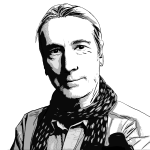
When all this Covid business began we were coming up to the March equinox, the point at which, in this hemisphere, there are more hours of daylight than there are of darkness. It was a dark time, but the light made it easier to deal with.
Covid struck in the time of life and growth and during lockdown many found comfort and joy in nature. Even David Attenborough was grounded, and revelled instead in the birds in his garden in Richmond. The emergency gave us all enforced leisure: people noticed the wild world more than usual. We paused to look at living things in gardens and parks and the countryside, stuff we’d been too busy to see before. And it was more wonderful than anyone expected.
Spring is the most exciting time of year, when everything around is concerned with pairing up, copulating, fighting, singing and raising young. Nature was making more nature and for the first time years people paid attention. A book of mine, full of tips on how to look at nature, had a very gratifying second spike in sales.
But now the rather less gratifying Covid second spike is with us. There are more restrictions in place, and no doubt more to come. The reckless mood of late summer – we’ve cracked it, let’s have fun again – has been replaced by one of dismay. We’ve passed the September equinox, there are now more hours of darkness than of light and the second spike is going to be tougher to deal with than the first. A lot darker, too.
We need nature more than ever, but nature is shutting down for winter. So where can we find the distraction, delight, comfort and joy we all need? Why, in nature of course. Autumn and winter are as fabulous as any other season. It’s just a matter of getting your eye in.
Winter is hard: every wild creature you see is operating a strategy with one aim in view. That aim is Not Dying. If you can pull this off, the next spring is all yours. Whatever you do today, get through to tomorrow. That too is life-affirming: how could it not be? The new Covid wave is grim: we must be grim and bear it. The best way to do that is by tuning in to nature.
And it’s a great time to start learning birdsong. That’s because there’s only one bird singing. Robins are the only species that routinely sing complex songs from autumn through the winter and if you listen you can get it fixed in your mind: a sweet, thin song. Some find it sad, though not me.
Robins sing because, unlike the rest, they hold territory throughout the winter. They defend the places where they feed from other robins, and song is their first line of defence. It means I’m here, please go away and it’s a song of survival. Listen to it and allow yourself a smile. It’s a message for us all: hang tough.
Now listen out for a more simple sound: si-si-si! You’ll hear it in parks and gardens as well as wilder places, quite loud, urgent, and usually much repeated. This is a feeding party of long-tailed tits, calling, not singing. It means I’m here, where are you? The calls keep the flock together and keep them safe. They shut up the instant they perceived danger, so silence is an alarm signal.
Birds change their behaviour in the darker months. Many of them abandon the idea of being half of a pair and become part of flock, because there is safety in togetherness. That’s why other species join the foraging long-tailed tits, taking advantage of the clatter and chatter of their progress, and the warning silences. You’ll see parties of them moving from tree to trees; the funky stick-and-ball shape of the long-tailed tits is absolutely distinctive.
The most spectacular demonstration of the safety-in-numbers principle comes from starlings. They are overlooked birds in gardens and city centres for most of the year, but in winter they gather in flocks and sometimes at dusk they dance. It’s called a murmuration: strange, oozing, shifting patterns in the sky, apparently controlled by a single mind.
There are many theories about this. I see it as a celebration of togetherness. Safety in numbers is great idea but not much fun: a murmuration makes it fun, allowing every bird to celebrate membership of the flock and increase flock solidarity. Make a point of looking for a murmuration as we move towards the solstice in December: a website called starlingsintheuk.co.uk offers a map of murmurations.
Winter is a crisis. Many birds cope with it by being somewhere else: by migrating south, some as far as South Africa; Arctic terns go all the way to Antarctica. Hedgehogs and bats cope by hibernating. In an outbuilding you might find what looks like a dead black butterfly: it’s actually a gorgeous peacock, wings folded, in a state called diapause, from which it will wake in the spring if all goes well.
Non-hibernating mammals restrict their activities to the minimum, feeding when they can and lying up as much as possible, hoarding energy as a miser hoards gold. As the ground gets softer with rain, keep an eye on the ground for footprints. Even in the suburbs you’re like to find the hoof-prints of deer, like two sugared almonds.
How extraordinary the seasons are. We live among them and so the steady state of the always-green rainforest seems far more thrilling – but consider the most ordinary semi-natural space in Europe. The difference between summer and winter is so immense you might be in a different place entirely.
The leaves are starting to turn now, and to fall. Plants live on light, but deciduous trees abandon their light-eating devices in autumn and as they do, they change colour in the most dramatic way. They will starve themselves for months in a state not unlike sleep, living off stored resources in their roots. Other plants overwinter as seeds. Everything that lives needs a strategy to solve the problem of Not Dying.
But for some species Britain in winter is a balmy resort, the perfect place to spend a few months before flying north again. Always keep an eye on the berry-bushes in parks and gardens and especially supermarket car parks: every now and then sudden flocks of waxwings will descend and gorge: perhaps the most exotic sight in Britain.
Redwings and fieldfares are thrushes that come down from Scandinavia to bask in the warm of the British winter. And in some places you will find big numbers of blackbirds, all male: glossy and black with banana-yellow beaks.
Many of these will be more Scandinavian holiday-makers. The females fly further south, to warmer weather where survival is more likely. But the males prefer Britain. They aim to fly back to the breeding-grounds as soon as the weather gets warm again. Once there they will sing hard and establish a territory, all ready for when the females get back.
Many ducks, geese, swans and wading birds come here for the winter as well. At low tide the mud of river estuaries will be packed with birds, all probing the mud with their beaks. The coasts of Britain are internationally important: the mudflats are packed with life.
The most spectacular of all the wintering birds are swans: not the familiar mute swans of lakes and river, but whooper and Bewick’s swans that come hammering in from the north, from their breeding grounds in Siberia and Iceland.
They are birds of habit and return to the same places every year. Many of these are looked after by the Wildfowl and Wetland Trust: Slimbridge in Gloucestershire, Welney on the Norfolk-Cambridgeshire border, Martin Mere in Lancashire. These are marvellous pilgrimage spots: a chance to meet birds that fly for endless miles because our winters are so delightful. They are big and bold and they sound like bugles, they have big splashes of yellow on their beaks, and they come here because of all the places in the world, this is best for Not Dying.
So as the Covid second spike establishes itself and optimism gives way to a grim acceptance of the way things are, we can once again turn to nature. Nature in winter is more challenging and there are fewer hours of daylight to appreciate it – but you can still get out and savour the processes of life going on all around.
Winter is tough, and it’s supposed to be. It’s tough for swans and robins, it’s tough for peacock butterflies and deer and it’s going to be tougher than usual for us humans. Winter is for living through: making the best of each passing day. Nature will help us to do so, if we let it. We need it more than ever.










